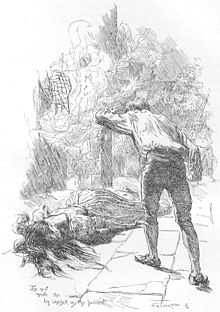Bertha Mason


Bertha Antoinetta Mason is a fictional character. In Charlotte Brontë's 1847 novel Jane Eyre she is the violently insane first wife of Edward Rochester, moved to Thornfield Hall and locked in the attic.[1]
The 1966 parallel novel Wide Sargasso Sea by Jean Rhys acts as a prequel to Brontë's novel and is the story of Mason (there called Antoinette Cosway), from the time of her youth in the Caribbean to her unhappy marriage and relocation to England. Rhys's novel re-imagines Brontë's devilish madwoman in the attic.
Bertha Mason in Jane Eyre
Bertha Mason is the only daughter of a very wealthy family living in Spanish Town, Jamaica. The reader learns of her past not from her perspective but only through the description of her unhappy husband, Edward Rochester. She is described as being of Creole heritage. According to Rochester, Bertha was famous for her beauty: she was the pride of the town and sought after by many suitors. Upon leaving college, Rochester was persuaded by his father to visit the Mason family and court Bertha. As he tells it, he first met her at a ball she attended with her father and brother Richard, where he was entranced by her loveliness. Despite never being alone with her, and supposedly having had scarcely any interaction or conversation with her, he married her for her wealth and beauty, and with fierce encouragement from his own father and the Mason family. Rochester and Bertha began their lives as husband and wife in Jamaica. In recounting the history of their relationship, Rochester claims, "I thought I loved her. . . . Her relatives encouraged me; competitors piqued me; she allured me: a marriage was achieved almost before I knew where I was. Oh, I have no respect for myself when I think of that act! . . . I never loved, I never esteemed, I did not even know her."[2]
Rochester explains that he was not warned that violent insanity ran in the Mason family and that the past three generations succumbed to it. He assumed Bertha's mother to be dead and was never told otherwise, but she was in fact locked away in an asylum. There was also an intellectually disabled younger brother. Rochester's father knew of this but did not bother to tell his son, caring only about the vast fortune the marriage would bring him, and the Mason family clearly wanted Bertha off their hands as quickly as possible. Rochester asserts that Bertha's mental health deteriorated quickly, though it is unclear which form of mental illness she suffers from. Her insane, violent behaviour becomes frightening to behold: crawling on all fours, snarling, and behaving in a bestial manner.[3]
Rochester returns with her to England and has her imprisoned in an attic room for ten years with Grace Poole, a hired nurse who keeps her under control while Rochester travels abroad to forget his horrible marriage. However, Grace drinks sometimes, and Bertha manages to escape, causing havoc in the house: starting a fire in Mr Rochester's bed and biting and stabbing her own visiting brother.[4]
Rochester's marriage to Bertha eventually stands in the way of his marrying Jane Eyre, who is unaware of Bertha's existence and whom he truly loves (though he later admits to Jane that he once thought he loved Bertha). As Bertha is insane he cannot divorce her, due to her actions being uncontrollable and thus not legitimate grounds for divorce. Years of violence, insanity, and confinement in an attic destroy Bertha's looks: when Jane sees her in the middle of the night, she describes Bertha as looking "savage," even going so far as to compare her with a "vampire"[5] when she destroys Jane's wedding veil (an action that hints that Bertha is at least sane enough to be aware that her husband is planning to enter a bigamous marriage). Despite not loving her, Rochester attempts to save his wife from an enormous fire she starts in the house when she again escapes. Bertha perishes after she throws herself off the roof, leaving her husband free to marry Jane.
Antoinette Cosway in Wide Sargasso Sea
In Wide Sargasso Sea, Antoinette Cosway is lively yet vulnerable. She is no longer a cliché or a "foreign", possibly "half-caste" lunatic, but a real woman with her own hopes, fears, and desires. Wide Sargasso Sea tells her side of the story as well as Rochester's, detailing how she ended up alone and raving in the attic of Thornfield Hall. Antoinette's insanity, infidelity, and drunkenness are the result of Rochester's misguided belief that madness is in her blood and that she was part of the scheme to have him married blindly.
The characters of Jane Eyre and Antoinette are very similar. They are both independent, vivacious, imaginative young women with troubled childhoods, educated in religious establishments and looked down on by the upper classes — and, of course, they both marry Mr Rochester. However, Antoinette is more rebellious than Jane and less mentally stable, possibly because she has had to live through even more distressing circumstances. She displays a deep vein of morbidity verging on a death wish (making her more similar perhaps to the character of Helen from Jane Eyre) and, in contrast with Jane's overt Christianity, holds a cynical viewpoint of both God and religion in general.
References
- ↑ Jane Eyre at Project Gutenberg. Retrieved 8 January 2013.
- ↑ Jane Eyre ("Well, Jane, being so...") at Project Gutenberg. Retrieved 8 January 2013.
- ↑ Jane Eyre ("My bride’s mother I had never seen...") at Project Gutenberg. Retrieved 8 January 2013.
- ↑ Jane Eyre ("To England, then...") at Project Gutenberg. Retrieved 8 January 2013.
- ↑ Jane Eyre ("Of the foul German spectre—the Vampyre.") at Project Gutenberg. Retrieved 8 January 2013.